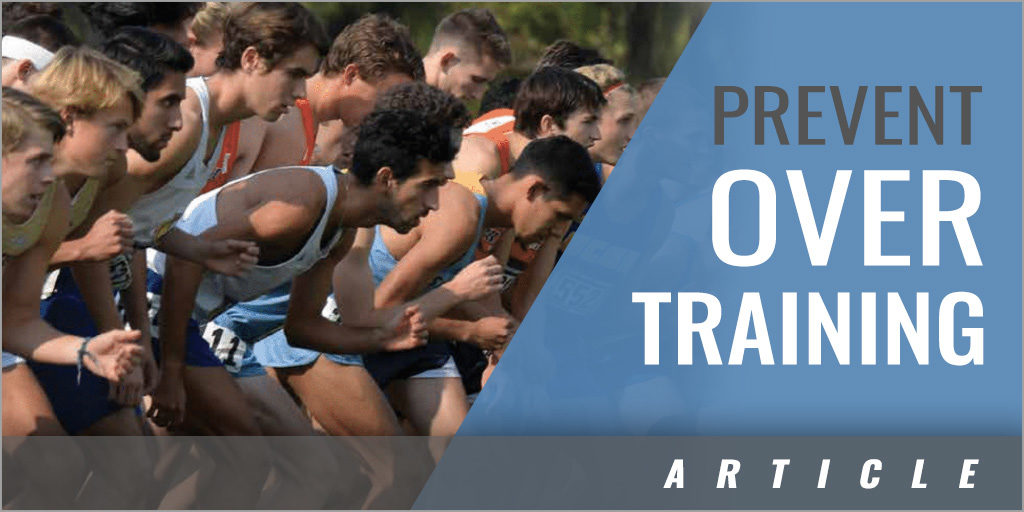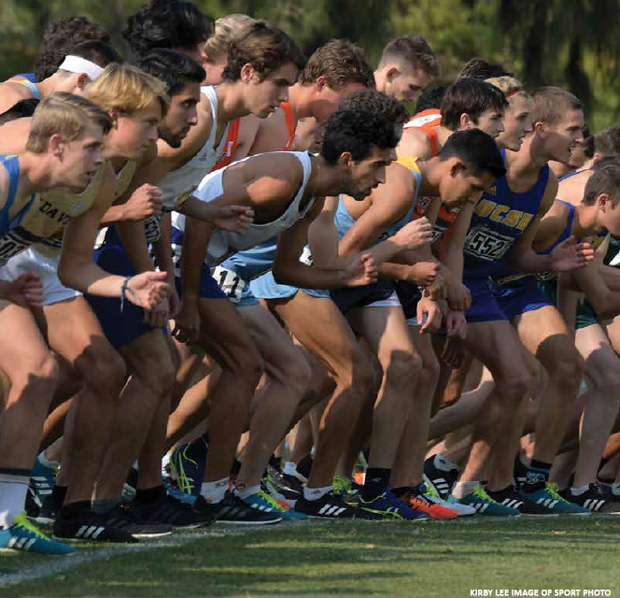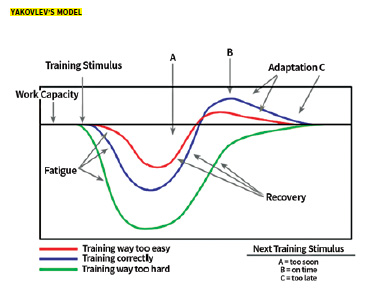|
By: David Granato Originally Published in: Techniques Magazine Provided by: USTFCCCA
Collegiate distance runners, especially those attempting to compete at a high level, must balance the physical and psychological stresses of training, with the academic demands placed on all students. Success at the highest levels of the sport requires training and recovering like a professional, without the additional time and resources available to professional runners. The purpose of training is to stress the physiological system beyond what it is accustomed to, often called Over Reaching, in an attempt to elicit a super compensation response. If an athlete trains too little, underperforming, or failure to improve, is likely; train too hard, however, and performance will be negatively affected far more, as well as the risk of injury being dramatically increased. This is best illustrated by Yakovlev's model. Failure to adhere to these principles can result in Over Training Syndrome. Over Training Syndrome is the result of a chronic imbalance of stress and recovery (18), and is characterized by a longterm loss in performance, that can take weeks or months to recover from (11).
STAGES OF OVER TRAINING SYNDROME Researchers delineate between three stages of Over Training: Functional Over Reaching, Non-Functional Over Reaching, and Over Training Syndrome (18). Functional Over Reaching is defined as an increase in training load, which results in a decrease in performance, that can last from several days to several weeks (18). Functional Over Reaching is then characterized by a performance increase, following a few days to a week of reduced training (12, 18). This performance increase is known as the super compensation response to training (12), illustrated by the blue line in the diagram above. The second stage, Non-Functional Over Reaching, is defined as an increase in training leading to a longer performance detriment, lasting several weeks to several months, as well as the onset of biochemical symptoms (12). A full recovery can be made with total rest or reduced training for up to several weeks (12). This is illustrated by the green line in the diagram above. The third stage, Over Training Syndrome, is characterized by a per-formance detriment similar, though more severe and longer lasting, to Non-Functional Over Reaching, as well as more severe biochemical symptoms (12). The main delineation between Non-Functional Over Reaching and Over Training Syndrome is the amount of time required to recover (12). Over Training Syndrome can take weeks, or even months, to recover from, with the most severe cases resulting in the end of an athletic career (12). There is no clear line between Over Training Syndrome and either of the stages of Over Reaching. The three stages are dif-ferentiated based on the length of recovery to normal function required, and whether a super compensation response exists (12). This delineation can only be made retroactively. Over Reaching is primarily and intentionally undertaken with the purpose of eliciting a super compensation response in the athlete, leading to higher levels of performance. However if the period of Over Reaching goes on for too long, or not enough recovery is taken, then it can progress to Over Training Syndrome (12). PREVALENCE OF OVER TRAINING SYNDROME Researchers interviewed 376 English youth athletes, with an average age of 15, to determine how often each had experienced the symptoms of Over Reaching and Over Training (16). The researchers looked at athletes from the club level, to regional, national, and international levels in nineteen different sports. The researchers showed that all levels and sports showed incidence of Non-Functional Over Reaching, averaging 29% of athletes across sports (16). The incidence of symptoms was shown to occur more than twice as often in individual sports 37%, over team sports 17% (16). Sports that are highly physically demanding had a greater incidence of Non-Functional Over Reaching 34%, compared to less physically demanding sports 25% (16). The researchers also found that female athletes were at greater risk of developing symptoms of Non-Functional Over Reaching 36%, than males 26% (16). Finally, athletes competing at the national and international level were shown to have higher incidence than those competing at the local and club level (16). A different group of researchers conducted a similar study, interviewing 139 athletes from Switzerland, with a median age of 23.6 (2). They interviewed athletes from 26 different sports, focusing mainly on athletes that were currently competing at the national and international level in those sports (2). The researchers found that 9% of the athletes they interviewed had suffered from symptoms of Over Training Syndrome at some point in their athletic career (2). The researchers also found that 21% of the athletes they interviewed had suffered from Non-Functional Over Reaching at some point in their career (2). It is important to remember that these are the athletes that had survived in the sport to their mid-twenties, and continued to compete at the national and international level. Those athletes that did not make it until that point, perhaps as a result of Over Training Syndrome, never had the opportunity to be interviewed, and as such the incidence could be much higher. SIGNS AND SYMPTOMS OF OVER TRAINING SYNDROME Over Training Syndrome has many negative symptoms, and not all will be present in every athlete. What follows is a general overview of the most common symptoms and how they manifest in athletes. The main symptoms associated with Over Training Syndrome are: depression, perceived stress, fatigue, sleep disturbance, soreness, loss of appetite, apathy, a lack of emotional stability and irritability, as well as a high susceptibility to upper respiratory tract infection, low vigor, and decreased self-esteem (3, 5, 6, 11, 14, 21). All of these symptoms come together, culminating in a decrease in maximal aerobic power below baseline levels, during periods of Functional Over Reaching (3, 9, 11). While moderate training is usually associated with good sleep patterns, Over Reaching and Over Training correlate with decreased sleep efficiency, less total time asleep, increased restlessness, and more frequent waking up during the night (9). These disturbed patterns disappear when the training load is reduced (9). Over Training Syndrome also causes specific, measurable changes in the bio-chemical homeostasis of the body. The typical response to training is lower post exercise cortisol levels, compared to baseline and pre-training levels (8, 20). Athletes currently suffering from Over Training Syndrome have been found to have cortisol levels that are higher than resting levels, following an acute exercise bout (19). Athletes currently recovering from Over Training and healthy athletes have been found to have cortisol levels lower than baseline post-exercise (19). This indicates that post-exercise cortisol testing would be the best biochemical measure of Over Training Syndrome, provided there is a baseline measure for comparison (19).
Cortisol is a stress hormone, released when the body is under physical, or psychological stress. In the right amounts, it is beneficial to training adaptations, however too much will have negative effects. Among other negative effects, the increased stress hormone levels result in a lowered ability of the immune system to fight infection (15). Imbalanced training loads and recovery have been shown to result in a higher instance of illness, especially upper respiratory tract infections (9). WHY COLLEGIATE DISTANCE RUNNERS ARE AT HIGH RISK Physiological, as well as psychological, stresses are both contributing factors to Over Training Syndrome (10). Because of this combination, student-athletes are at high risk for developing Over Training Syndrome (21). Student-athletes face multiple sources of stress associated with their academic and athletic activities that professional athletes, and students who are not athletes, do not face (21). Due to the individual nature of distance running, as well as the high physical demand placed on athletes by themselves and their coaches, collegiate distance runners are at an especially high risk of developing Non-Functional Over Reaching and Over Training Syndrome. DIAGNOSIS OF OVER TRAINING SYNDROME Over Training Syndrome is usually diag-nosed by exclusion; only when other possible causes of performance detriment have been eliminated can it be determined if Over Training Syndrome is present (20). Diagnosis presents a challenge for coaches and athletes, who need a way to preempt the negative effects of Over Training before they manifest, so as to avoid losing time and fitness to the necessary recovery period. The challenge is to find the optimal level of stress and recovery for each athlete. Monitoring biochemical indicators is one possible way to objectively measure stress and recovery for individual athletes. QUANTIFYING STRESS USING SALIVARY CORTISOL Coaches can use salivary cortisol measures as a relatively easy, and non-invasive way to quantify stress, and avoid Over Training Syndrome. The advantage to salivary cortisol over blood cortisol measures is that it is easier for the researcher to collect in large numbers, is less expensive, less invasive, and less disruptive to the athlete. These advantages make it more accessible, and preferable, to coaches and practitioners. To collect salivary cortisol, a sanitary cotton ball is held in the mouth for two minutes, beginning approximately thirty minutes after the cessation of intense exercise. Salivary cortisol has been shown to peak between thirty and sixty minutes after the cessation of intense exercise (4, 12). The saturated cotton balls should be spit into, and stored in, sealable polypropylene tubes, due to polypropylene's low absorption rate of steroid hormones. If samples are not going to be immediately analyzed, they should be stored in a freezer set to at least -20C, so that the cortisol levels do not degrade. In order to analyze the samples, an ELISA kit and microplate reader are required to determine salivary cortisol levels. The ELISA is an Enzyme Linked Immunosorbent Assay, which utilizes antibodies that detect a specific substance. An ELISA kit specific to cortisol must be used. In an ELISA, the antibodies are coupled with an enzyme that produces a color change in response to the level of cortisol detected in the sample. The colored samples from the ELISA kit are then put into a microplate reader, which utilizes a light source on one side of the sample well to illuminate the sample using a specific wavelength. A light detector located on the other side of the sample well measures how much of the light is transmitted through the sample. A higher level of light transmission through the sample means a lower level of the substance is present. The microplate reader will provide a digital readout with the exact amount of the substance present in the sample.
This data, when compared to the baseline, gives the ability to quickly and easily quantify stress, and when extra rest might be needed to avoid Over Training Syndrome. ALTERNATIVES SALIVARY CORTISOL MEASURING KITS Simpler, though less accurate, test kits exist as well. These home test kits, which include reactive color strips that, after introduction to saliva, are compared by eye to an included chart. Currently no such product exists, but a way to measure blood cortisol as quickly and easily as blood lactate would be the best and easiest way to obtain such a measurement, provided measuring is done properly. STRATEGIES TO PREVENT OVER TRAINING SYNDROME Proper periodization of training, as well as modifications for the individual athlete, is the best way to ensure that Over Training does not occur. These scientific concepts must be combined with the ability to listen to your athlete. The best program in the world might need to be changed to accommodate student athletes and the outside stressors they are placed under. Strictly following a plan, regardless of outside factors, is a recipe for underperformance. REFERENCES Bompa, T., & Buzzlichelli, C. Birrer, D., Lienhard, D., Williams, C. A., Rothlin, P., & Morgan, G. (2013). Prevalence of non-functional overreaching and the overtraining syndrome Coutts, A. J., Slattery, K. M., & Wallace, L. K. (2007). Practical tests for monitoring performance, fatigue and recovery in triathletes. Journal of Science and Medicine in Sport, 10(6), 372-381. Crewther, B., Cronin, J., Keogh, J., & Cook, C. (2008). The salivary testosterone and cortisol response to three loading schemes. The Journal of Strength & Conditioning Research, 22(1), 250-255. Filaire, E., Lac, G., & Pequignot, J. M. (2003). Biological, hormonal, and psychological parameters in professional soccer players throughout a competitive season. Perceptual and Motor Skills, 97(3f), 1061-1072. Grobbelaar, H. W., Malan, D. D. J., Steyn, B. J. M., & Ellis, S. M. (2011). The relationship between burnout and mood state among student rugby union players. African Journal for Physical, Health Education, Recreation and Dance, 7(4), 647-664. Gustafsson, H., Holmberg, H. C., & Hassmen, P. (2008). An elite endurance athlete's recovery from underperformance aided by a multidisciplinary sport science support team. European Journal of Sport Science, 8(5), 267-276. Handziski, Z., Maleska, V., Petrovska, S., Nikolik, S., Mickoska, E., Dalip, M., & Kostova, E. (2006). The changes of ACTH, Hausswirth, C., Louis, J., Aubry, A., Bonnet, G., Duffield, R., & Le Meur, Y. (2014). Evidence of disturbed sleep and increased illness in overreached endurance athletes. Med Sci Sports Exerc, 46(5), 1036- 1045. Kellmann, M. (2010). Preventing overtraining in athletes in high-intensity sports and stress/recovery monitoring. Scandinavian Journal of Medicine & Science in Sports, 20(s2), 95-102. Kentta, G., Hassmen, P., & Raglin, J. S. (2006). Mood state monitoring of training and recovery in elite kayakers. European Journal of Sport Science,6(4), 245-253. Kirschbaum, C., & Hellhammer, D. H. (2000). Salivary cortisol. Encyclopedia of Stress, 3(379-383). Kreher, J. B., & Schwartz, J. B. (2012). Overtraining syndrome; a practical guide. Sports Health: a Multidisciplinary Approach, 4(2), 128-138. Main, L., & Grove, J. R. (2009). A multi-component assessment model for monitoring training distress among athletes. European Journal of Sport Science,9(4), 195-202. Marketon, J. I. W., & Glaser, R. (2008). Stress hormones and immune function. Cellular immunology, 252(1), 16-26. Matos, N. F., Winsley, R. J., & Williams, C. A. (2011). Prevalence of nonfunctional overreaching/overtraining in young English athletes. Med Sci Sports Exerc, 43(7), 1287-94. McNair, D., & Heuchert, J. (2012). Profile of Mood States, POMS2 (Second ed.). North Tonawanda, N.Y.: Multi-Health Systems. Meeusen, R., Duclos, M., Gleeson, M., Rietjens, G., Steinacker, J., & Urhausen, A. (2006). Prevention, diagnosis and treatment of the overtraining syndrome: ECSS position statement 'Task Force'. European Journal of Sport Science, 6(01), 1-14. Nederhof, E., Zwerver, J., Brink, M., Meeusen, R., & Lemmink, K. A. P. M. (2008). Different diagnostic tools in nonfunctional overreaching. International Journal of Sports Medicine, 29(7), 590-597. Tobar, D. A. (2012). Trait anxiety and mood state responses to overtraining in men and women college swimmers. International Journal of Sport and Exercise Psychology, 10(2), 135-148. Wilson, G. S., & Pritchard, M. (2005). Comparing sources of stress in college student athletes and non-athletes. Athletic Insight. DAVID GRANATO IS AN ASSISTANT COACH AT ADAMS STATE WORKING WITH DISTANCE AND MID-DISTANCE ATHLETES.
|











